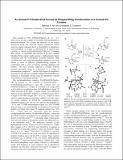| dc.contributor.author | Piro, Nicholas A. | |
| dc.contributor.author | Cummins, Christopher C. | |
| dc.date.accessioned | 2011-06-30T18:16:28Z | |
| dc.date.available | 2011-06-30T18:16:28Z | |
| dc.date.issued | 2009-06 | |
| dc.identifier.issn | 0002-7863 | |
| dc.identifier.issn | 1520-5126 | |
| dc.identifier.uri | http://hdl.handle.net/1721.1/64726 | |
| dc.description.abstract | The terminal phosphorus monoxide complex [(OP)Mo(N[superscript t Bu]Ar) subscript 3], 1 (Ar = 3,5-Me2C6H3) [1 (Ar = 3,5-Me subscript 2 C subscript 6 H subscript 3)], undergoes an O-for-PSiR3 [O-for-PSiR subscript 3] metathesis reaction with the niobium phosphinidene complex iPr3SiPNb(N[CH2tBu]Ar)3 [superscript i Pr subscript 3 SiPNb(N[CH subscript 2 superscript t Bu]Ar) subscript 3], 2, to generate the oxoniobium complex ONb(N[CH2tBu]Ar)3 [ONb(N[CH subscript 2 superscript t Bu]Ar) subscript 3], 3, and the diphosphenido complex iPr3SiPPMo(N[tBu]Ar)3 [superscript i Pr subscript 3 SiPPMo(N[superscript t Bu]Ar) subscript 3], 4. The structure of 4, as determined by X-ray crystallography, contains a “singly bent” diphosphenido moiety, suggesting that the diphosphenido ligand serves as a 3e− donor to a formally d2 [d superscript 2] metal center. This bonding characterization was supported by DFT calculations and is unique among known diphosphenido complexes. Diphosphenido 4 was found to react over time to produce products consistent with a bimolecular degradation pathway where the terminal phosphide complex [PMo(N[superscript t Bu]Ar) subscript 3], 5, serves as a stable leaving group. Mixtures of 4 and PPh3 [PPh subscript 3] were observed to set up an equilibrium (Keq = 0.7) [(K subscript eq = 0.7)] between 4, PPh3 [PPh subscript 3], and the products of phosphinidene transfer, 5 and iPr3SiP═PPh3 [superscript i Pr subscript 3 SiP═PPh subscript 3]. | en_US |
| dc.description.sponsorship | National Science Foundation (U.S.) (Grant CHE-719157) | en_US |
| dc.description.sponsorship | Thermphos (Firm) | en_US |
| dc.language.iso | en_US | |
| dc.publisher | American Chemical Society | en_US |
| dc.relation.isversionof | http://dx.doi.org/10.1021/ja903860k | en_US |
| dc.rights | Article is made available in accordance with the publisher's policy and may be subject to US copyright law. Please refer to the publisher's site for terms of use. | en_US |
| dc.source | Prof. Christopher Cummins | en_US |
| dc.title | An Unusual P-P Double Bond Formed via Phospha-Wittig Transformation of a Terminal PO Complex | en_US |
| dc.type | Article | en_US |
| dc.identifier.citation | Piro, Nicholas A., and Christopher C. Cummins. “An Unusual P−P Double Bond Formed via Phospha-Wittig Transformation of a Terminal PO Complex.” Journal of the American Chemical Society 131.25 (2009) : 8764-8765. Copyright © 2009 American Chemical Society | en_US |
| dc.contributor.department | Massachusetts Institute of Technology. Department of Chemistry | en_US |
| dc.contributor.approver | Cummins, Christopher | |
| dc.contributor.mitauthor | Piro, Nicholas A. | |
| dc.contributor.mitauthor | Cummins, Christopher C. | |
| dc.relation.journal | Journal of the American Chemical Society | en_US |
| dc.eprint.version | Author's final manuscript | en_US |
| dc.type.uri | http://purl.org/eprint/type/JournalArticle | en_US |
| eprint.status | http://purl.org/eprint/status/PeerReviewed | en_US |
| dspace.orderedauthors | Piro, Nicholas A.; Cummins, Christopher C. | en |
| dc.identifier.orcid | https://orcid.org/0000-0003-2568-3269 | |
| mit.license | PUBLISHER_POLICY | en_US |
| mit.metadata.status | Complete | |
